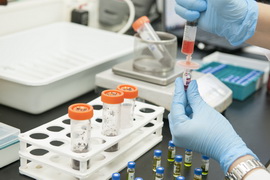
Researchers Discover Off-Switch to CRISPR-Cas9 Gene Editing System
January 18, 2017| |
 Researchers from the University of California, San Francisco have found a way to switch off the CRISPR-Cas9 gene editing system using newly identified anti-CRISPR proteins that are produced by bacterial viruses. The newly discovered anti-CRISPR proteins could enable more precise control in CRISPR applications, but also provide a fail-safe to quickly block any potentially harmful uses of the technology.
Researchers from the University of California, San Francisco have found a way to switch off the CRISPR-Cas9 gene editing system using newly identified anti-CRISPR proteins that are produced by bacterial viruses. The newly discovered anti-CRISPR proteins could enable more precise control in CRISPR applications, but also provide a fail-safe to quickly block any potentially harmful uses of the technology.
To find an anti-CRISPR protein that would work against the CRISPR-Cas9 system used in most labs which depends on a protein called SpyCas9 as its targeted DNA clippers, the researchers thought that they should be able to identify bacteria with inactivated CRISPR systems. This can be conducted by looking for evidence of so-called "self-targeting" – bacterial strains where some virus had successfully gotten through the Cas9 blockade and inserted its genes into the bacterial genome.
The research team examined nearly 300 strains of Listeria, and found that 3 percent of strains exhibited "self-targeting." Further investigation isolated four distinct anti-CRISPR proteins that proved capable of blocking the activity of the Listeria Cas9 protein, which is very similar to SpyCas9.
Further research showed that two of the four anti-CRISPR proteins, called AcrIIA2 and AcrIIA4 by the researchers, worked to inhibit the ability of the commonly used SpyCas9 to target specific genes in other bacteria, as well as in engineered human cells. Together, the results suggest that AcrIIA proteins are potent inhibitors of the CRISPR-Cas9 gene editing system as it has been adopted in labs around the world.
For more details, read the news release from UC San Francisco.
| |
Biotech Updates is a weekly newsletter of ISAAA, a not-for-profit organization. It is distributed for free to over 22,000 subscribers worldwide to inform them about the key developments in biosciences, especially in biotechnology. Your support will help us in our mission to feed the world with knowledge. You can help by donating as little as $10.
-
See more articles:
-
News from Around the World
- International Research Team Develops Much Needed Genetic Resource in Improving Wheat Varieties
- Bibliotheca Alexendrina Holds Workshop on Ethics in Gene Editing
- USDA Deregulates GE Creeping Bent Grass
- ORNL Researchers Release Largest Poplar SNP Dataset
- White House Announces 2017 Update to the Coordinated Framework for the Regulation of Biotechnology
- Punjab Agri Minister Visits Biotech Corn Field
- BARI Scientists Apply for Commercial Release of GE Potato in Bangladesh
- EFSA Publishes Scientific Opinion for Renewal of Application for GM Maize 1507
-
Research Highlights
- Scientists Conduct Functional Characterization of Powdery Mildew Susceptibility Gene in Eggplant
- OsNAC6 Rice Transcription Factor Regulates Multiple Drought Tolerance Pathways
-
Beyond Crop Biotech
- Study Details Structure of Immature Zika Virus
- Researchers Crack Arabica Coffee Genome
-
Announcements
- 2nd International Conference on BioScience and Biotechnology
-
Plant
- Enhancement of Fatty Acid Composition in Camelina using CRISPR/Cas9
- Researchers Discover Off-Switch to CRISPR-Cas9 Gene Editing System
-
Read the latest: - Biotech Updates (December 17, 2025)
- Gene Editing Supplement (December 17, 2025)
- Gene Drive Supplement (February 22, 2023)
-
Subscribe to BU: - Share
- Tweet
